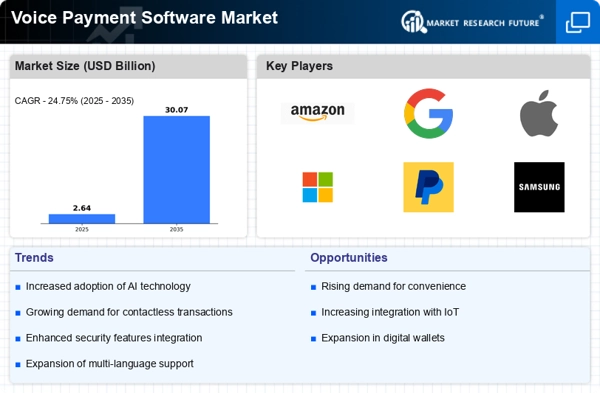Rising Adoption of Contactless Payments
The Voice Payment Software Market is experiencing a notable surge in the adoption of contactless payment methods. As consumers increasingly prefer seamless and efficient transaction processes, voice payment solutions are emerging as a convenient alternative. According to recent data, the contactless payment segment is projected to grow at a compound annual growth rate of over 20% in the coming years. This trend is driven by the growing demand for quick and secure payment options, particularly in retail and e-commerce sectors. The integration of voice technology into payment systems not only enhances user experience but also aligns with the broader shift towards digitalization in financial transactions. As a result, businesses are increasingly investing in voice payment software to meet consumer expectations and remain competitive in the evolving market landscape.
Growing Demand for Enhanced Customer Experience
The Voice Payment Software Market is witnessing a growing demand for enhanced customer experience. Businesses are increasingly recognizing the importance of providing a seamless and personalized payment process to retain customers and drive sales. Voice payment solutions offer a unique advantage by allowing users to complete transactions hands-free, which is particularly appealing in fast-paced environments. Recent market analysis suggests that companies implementing voice payment systems have reported a 15% increase in customer satisfaction rates. This trend is indicative of a broader shift towards prioritizing user experience in payment solutions. As organizations strive to differentiate themselves in a competitive landscape, the integration of voice technology into payment systems is likely to become a key strategy for enhancing customer engagement and loyalty.
Technological Advancements in Voice Recognition
Technological advancements in voice recognition are significantly influencing the Voice Payment Software Market. Innovations in artificial intelligence and machine learning have led to more accurate and efficient voice recognition systems. This progress is crucial as it enhances the reliability of voice payment solutions, thereby increasing consumer trust. Recent studies indicate that the accuracy of voice recognition technology has improved by approximately 30% over the past few years. As these technologies continue to evolve, they are likely to facilitate broader adoption of voice payment systems across various sectors, including banking, retail, and hospitality. The ability to process transactions through natural language commands not only streamlines the payment process but also caters to a diverse range of users, further propelling the market forward.
Increased Focus on Security and Fraud Prevention
The Voice Payment Software Market is increasingly characterized by a heightened focus on security and fraud prevention. As digital transactions become more prevalent, concerns regarding data breaches and fraudulent activities have escalated. Voice payment solutions are being developed with advanced security features, such as biometric authentication and encryption, to address these concerns. Recent reports indicate that the implementation of voice biometrics can reduce fraud rates by up to 50%. This emphasis on security not only protects consumers but also builds trust in voice payment systems. As businesses seek to reassure customers about the safety of their transactions, the demand for secure voice payment solutions is expected to rise, further driving market growth.
Expansion of E-commerce and Digital Payment Platforms
The Voice Payment Software Market is benefiting from the rapid expansion of e-commerce and digital payment platforms. As online shopping continues to gain traction, the need for efficient and user-friendly payment solutions has become paramount. Voice payment technology offers a streamlined approach to transactions, allowing consumers to make purchases quickly and conveniently. Recent statistics reveal that e-commerce sales are projected to reach over 6 trillion dollars by 2024, underscoring the potential for voice payment solutions in this sector. The integration of voice technology into e-commerce platforms not only enhances the shopping experience but also aligns with the growing trend of mobile commerce. As more businesses adopt voice payment systems, the market is likely to witness substantial growth in the coming years.


















Leave a Comment